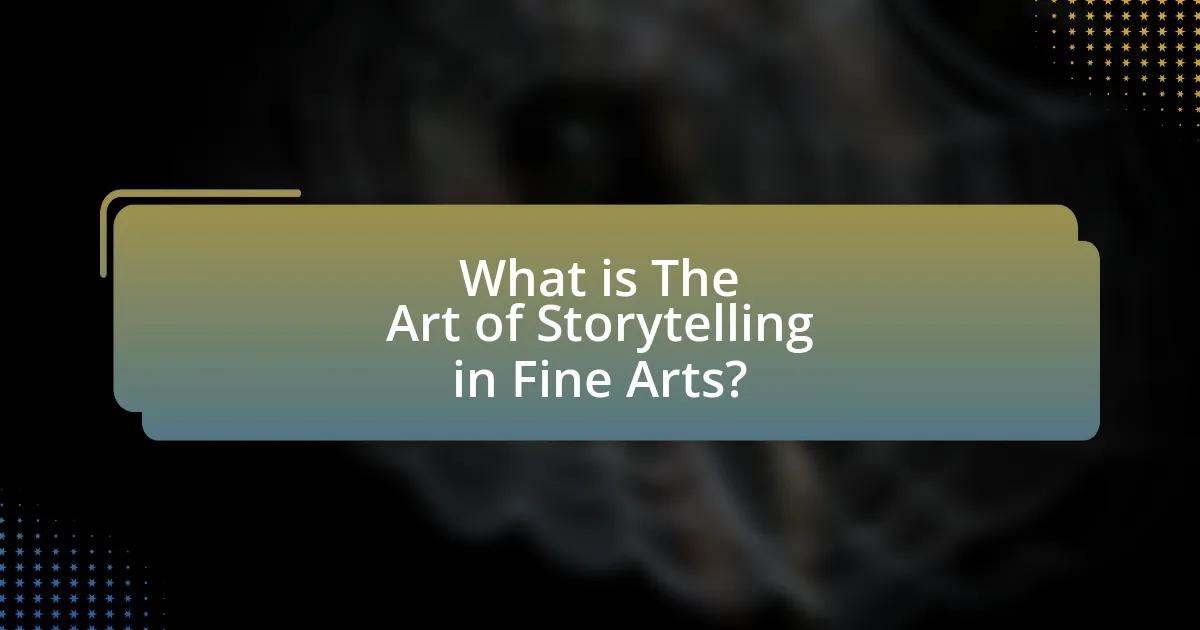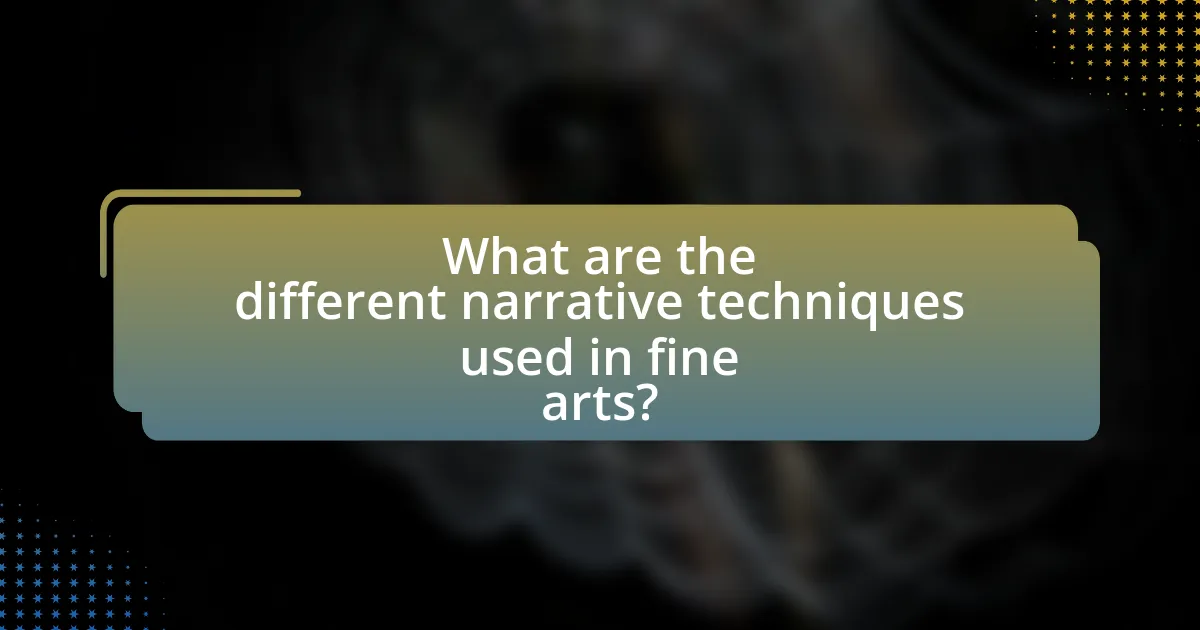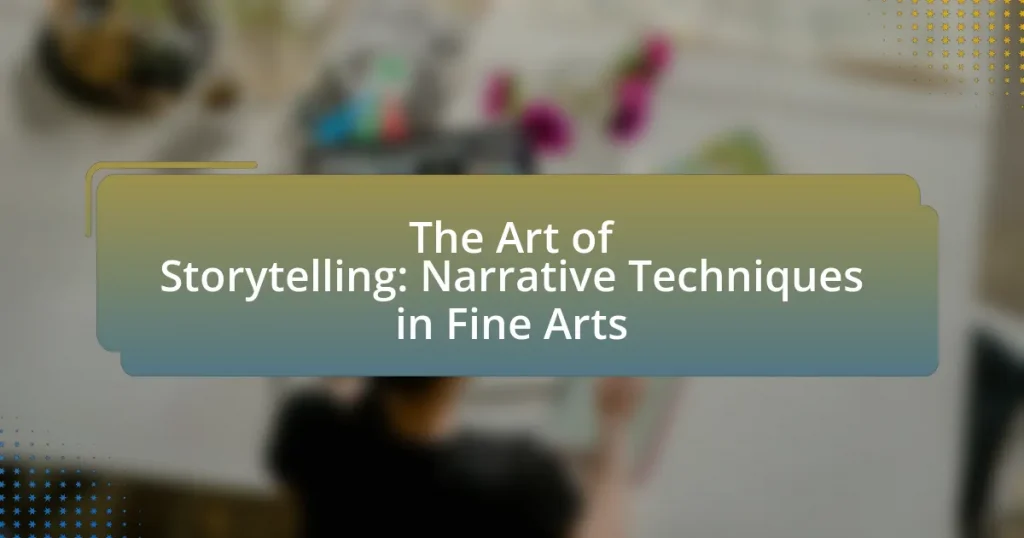The Art of Storytelling in Fine Arts explores the practice of conveying narratives through visual mediums such as painting, sculpture, and installation. This article examines how storytelling enhances the viewer’s experience by providing emotional depth and context, allowing for personal connections with the artwork. Key elements of storytelling, including character, setting, conflict, and resolution, are discussed, along with various narrative techniques like symbolism and composition. The article also highlights the importance of audience engagement and feedback in shaping effective storytelling within fine arts, offering strategies for artists to develop cohesive narratives in their work.

What is The Art of Storytelling in Fine Arts?
The Art of Storytelling in Fine Arts refers to the practice of conveying narratives through visual mediums such as painting, sculpture, and installation. This technique allows artists to communicate complex themes, emotions, and cultural narratives, often drawing from historical contexts or personal experiences. For instance, artists like Diego Rivera and Frida Kahlo utilized their works to reflect social issues and personal stories, effectively engaging viewers in a dialogue about identity and society. The integration of storytelling in fine arts enhances the viewer’s experience by inviting them to interpret and connect with the artwork on a deeper level.
How does storytelling enhance the experience of fine arts?
Storytelling enhances the experience of fine arts by providing context and emotional depth to visual works. When narratives are integrated into art, they allow viewers to connect with the piece on a personal level, fostering empathy and engagement. For instance, artworks that depict historical events or personal stories can evoke strong emotional responses, as seen in the works of artists like Frida Kahlo, whose paintings often reflect her life experiences and struggles. This narrative element not only enriches the viewer’s understanding but also encourages a more profound appreciation of the artistic intent and cultural significance behind the artwork.
What are the key elements of storytelling in visual art?
The key elements of storytelling in visual art include character, setting, conflict, and resolution. Characters are often depicted through figures or symbols that convey emotions and narratives. The setting establishes the context, influencing the mood and interpretation of the artwork. Conflict introduces tension or challenges faced by the characters, driving the narrative forward. Resolution provides closure, allowing viewers to reflect on the story’s outcome. These elements work together to engage the audience, prompting emotional responses and deeper understanding of the artwork’s message.
How do artists convey narratives through their work?
Artists convey narratives through their work by utilizing visual elements such as composition, color, and symbolism to tell stories. For instance, a painting may depict a scene that captures a specific moment in time, allowing viewers to infer the backstory and emotions of the subjects involved. Additionally, artists often employ techniques like juxtaposition and perspective to guide the viewer’s interpretation, creating a layered narrative experience. Historical examples include the use of allegory in Renaissance art, where figures and objects symbolize deeper meanings, effectively communicating complex narratives without words.
Why is storytelling important in the context of fine arts?
Storytelling is important in the context of fine arts because it enhances emotional engagement and provides deeper meaning to artistic expressions. Through narrative techniques, artists can convey complex themes, evoke empathy, and connect with audiences on a personal level. For instance, visual storytelling in paintings or sculptures allows viewers to interpret the artist’s message and experience a shared human condition, as seen in works like Picasso’s “Guernica,” which powerfully communicates the horrors of war. This connection between narrative and visual representation enriches the viewer’s understanding and appreciation of the artwork, making storytelling a fundamental aspect of fine arts.
What emotional responses does storytelling evoke in viewers?
Storytelling evokes a range of emotional responses in viewers, including empathy, joy, sadness, fear, and nostalgia. These emotions arise as narratives engage audiences through relatable characters and compelling plots, allowing viewers to connect with the experiences portrayed. Research indicates that storytelling activates brain regions associated with emotional processing, such as the amygdala and prefrontal cortex, enhancing the viewer’s emotional engagement. For instance, a study published in the journal “Cognitive Science” by Paul Zak found that narratives can increase oxytocin levels, a hormone linked to empathy and social bonding, demonstrating the profound impact storytelling has on emotional responses.
How does storytelling influence the interpretation of art?
Storytelling significantly influences the interpretation of art by providing context and emotional depth that shapes viewer understanding. When narratives are embedded within artworks, they guide the audience’s perception, allowing them to connect with the piece on a personal level. For instance, artworks that depict historical events or personal stories often evoke specific emotions and reflections, enhancing the viewer’s engagement. Research by M. J. Oatley in “A Cognitive Science Perspective on Narrative” highlights that narratives activate empathy and imagination, which can alter how art is perceived and appreciated. Thus, storytelling serves as a crucial framework that enriches the interpretative experience of art.

What are the different narrative techniques used in fine arts?
Different narrative techniques used in fine arts include visual storytelling, symbolism, perspective, and composition. Visual storytelling employs imagery to convey a narrative without words, allowing viewers to interpret the story through visual cues. Symbolism uses objects or colors to represent deeper meanings, enhancing the narrative’s emotional impact. Perspective, both literal and metaphorical, guides the viewer’s gaze and influences their understanding of the narrative context. Composition arranges elements within the artwork to create a focal point and direct the viewer’s attention, shaping the narrative flow. These techniques are essential in conveying complex stories and emotions in visual art.
How do visual elements contribute to storytelling in art?
Visual elements significantly contribute to storytelling in art by conveying emotions, setting contexts, and guiding viewer interpretation. For instance, color choices can evoke specific feelings; warm colors often suggest warmth or passion, while cool colors may imply calmness or sadness. Additionally, composition directs the viewer’s focus, highlighting key narrative elements and creating a sense of movement or tension. Historical examples, such as the use of light and shadow in Caravaggio’s works, illustrate how these elements can enhance dramatic storytelling by emphasizing contrasts and creating depth. Thus, visual elements are essential tools that artists utilize to craft compelling narratives within their artwork.
What role do color and composition play in narrative techniques?
Color and composition are essential elements in narrative techniques as they influence the emotional tone and visual storytelling of a piece. Color can evoke specific feelings and set the mood; for instance, warm colors like red and orange can create a sense of urgency or passion, while cool colors like blue and green can evoke calmness or sadness. Composition, on the other hand, refers to the arrangement of visual elements within a work, guiding the viewer’s eye and emphasizing key aspects of the narrative. For example, the rule of thirds can create balance and focus, while leading lines can draw attention to important subjects. Together, color and composition shape the viewer’s interpretation and engagement with the narrative, enhancing the overall storytelling experience.
How can symbolism enhance storytelling in visual arts?
Symbolism enhances storytelling in visual arts by providing deeper layers of meaning that engage viewers on an emotional and intellectual level. Through the use of symbols, artists can convey complex ideas, themes, and narratives without relying solely on literal representation. For example, the use of a broken chain in a painting can symbolize freedom or liberation, allowing the audience to interpret the artwork in a more profound context. This technique has been historically significant; artists like Pablo Picasso and Frida Kahlo employed symbolism to express personal and societal issues, thereby enriching the narrative and inviting multiple interpretations.
What are some examples of narrative techniques in famous artworks?
Examples of narrative techniques in famous artworks include the use of sequential imagery, symbolism, and perspective. Sequential imagery is exemplified in the “The Bayeux Tapestry,” which tells the story of the Norman Conquest through a series of embroidered scenes. Symbolism is prominently featured in “The Garden of Earthly Delights” by Hieronymus Bosch, where various elements represent moral and philosophical themes. Perspective is effectively utilized in “The School of Athens” by Raphael, where the arrangement of figures and architectural elements guides the viewer’s eye and conveys a sense of depth and interaction among the philosophers depicted. These techniques enhance storytelling by engaging viewers and inviting them to interpret the narratives embedded within the artworks.
How does the work of specific artists illustrate storytelling techniques?
The work of specific artists illustrates storytelling techniques through their use of visual elements to convey narratives. For example, Pablo Picasso’s “Guernica” employs fragmented forms and stark contrasts to depict the chaos and suffering of war, effectively communicating a powerful anti-war message. Similarly, Frida Kahlo’s self-portraits utilize symbolism and personal imagery to narrate her life experiences, emotions, and cultural identity, allowing viewers to engage with her story on a deeper level. These artists demonstrate how visual art can encapsulate complex narratives, making storytelling an integral part of their work.
What can we learn from analyzing narrative structures in classic pieces?
Analyzing narrative structures in classic pieces reveals fundamental storytelling techniques that shape audience engagement and thematic depth. By examining the frameworks of these narratives, we can identify patterns such as the hero’s journey, conflict resolution, and character development, which are prevalent in works like Homer’s “The Odyssey” and Shakespeare’s plays. These structures not only enhance the emotional resonance of the story but also provide insights into cultural values and human psychology, as seen in the archetypal characters and moral dilemmas presented. Understanding these elements allows contemporary creators to craft compelling narratives that resonate with audiences, demonstrating the timeless relevance of classic storytelling methods.

How can artists effectively implement storytelling in their work?
Artists can effectively implement storytelling in their work by integrating narrative elements such as character development, conflict, and resolution into their visual compositions. This approach allows artists to create a cohesive narrative that engages viewers emotionally and intellectually. For instance, the use of symbolism and visual metaphors can convey deeper meanings and evoke specific emotions, as seen in the works of artists like Frida Kahlo, whose paintings often reflect personal and cultural narratives. Additionally, artists can utilize techniques such as sequential imagery or series to unfold a story over time, similar to how graphic novels present narratives. This method not only captivates the audience but also encourages them to interpret and connect with the artwork on a personal level.
What strategies can artists use to develop narratives in their art?
Artists can develop narratives in their art by employing strategies such as character development, thematic exploration, and visual symbolism. Character development allows artists to create relatable figures that embody specific traits or experiences, engaging viewers emotionally. Thematic exploration involves selecting universal themes, such as love, conflict, or identity, which resonate with audiences and provide a framework for storytelling. Visual symbolism enhances narratives by using imagery that conveys deeper meanings, allowing viewers to interpret the artwork on multiple levels. These strategies are supported by art historical examples, such as the use of allegory in Renaissance paintings, where artists like Botticelli infused narratives with symbolic elements to convey complex ideas.
How can artists balance personal expression with audience engagement?
Artists can balance personal expression with audience engagement by integrating their unique perspectives into relatable themes. This approach allows artists to maintain authenticity while appealing to the emotions and experiences of their audience. For instance, artists can draw from personal narratives that resonate universally, such as love, loss, or identity, thereby creating a connection with viewers. Research indicates that artworks that evoke emotional responses tend to engage audiences more effectively, as seen in studies on viewer reactions to emotionally charged art. By skillfully blending personal stories with broader themes, artists can create works that are both personally meaningful and widely engaging.
What techniques can be used to create a cohesive narrative in a series of works?
To create a cohesive narrative in a series of works, techniques such as thematic consistency, character development, and intertextuality can be employed. Thematic consistency ensures that the underlying messages or motifs resonate across all pieces, creating a unified experience for the audience. Character development allows for deeper connections as characters evolve throughout the series, maintaining continuity and engagement. Intertextuality, which involves referencing or incorporating elements from previous works, reinforces the narrative thread and enriches the overall story. These techniques are supported by examples in literature and visual arts, where series like “The Lord of the Rings” and Picasso’s “Guernica” demonstrate how cohesive narratives enhance audience understanding and emotional impact.
What common challenges do artists face when incorporating storytelling?
Artists commonly face challenges such as balancing narrative depth with visual clarity when incorporating storytelling into their work. This difficulty arises because artists must convey complex narratives without overwhelming the viewer, which can lead to confusion or misinterpretation. Additionally, artists often struggle with integrating personal experiences into universal themes, as they aim to resonate with a broader audience while maintaining authenticity. Research indicates that 70% of artists report difficulties in maintaining coherence between visual elements and narrative structure, highlighting the importance of clarity in storytelling within fine arts.
How can artists overcome barriers to effective storytelling in their art?
Artists can overcome barriers to effective storytelling in their art by employing clear narrative structures and engaging visual elements. By utilizing techniques such as character development, thematic consistency, and emotional resonance, artists can create compelling narratives that resonate with audiences. Research indicates that artworks that incorporate identifiable characters and relatable themes enhance viewer engagement and understanding, as seen in studies on visual storytelling by scholars like Barbara Tversky and Julie Morrison. Additionally, artists can seek feedback from diverse audiences to refine their narratives, ensuring clarity and impact.
What resources are available for artists looking to improve their narrative techniques?
Artists looking to improve their narrative techniques can utilize a variety of resources, including books, online courses, workshops, and mentorship programs. Notable books such as “The Storytelling Animal” by Jonathan Gottschall and “The Anatomy of Story” by John Truby provide foundational insights into narrative structure and character development. Online platforms like MasterClass and Coursera offer courses specifically focused on storytelling in visual arts, taught by industry professionals. Additionally, workshops hosted by art organizations often provide hands-on experience and feedback, while mentorship programs can connect artists with experienced storytellers for personalized guidance. These resources collectively enhance an artist’s ability to convey compelling narratives through their work.
What are some best practices for storytelling in fine arts?
Best practices for storytelling in fine arts include creating a clear narrative structure, utilizing visual elements to enhance the story, and engaging the audience emotionally. A clear narrative structure helps guide the viewer through the artwork, making it easier to understand the intended message. Visual elements, such as color, composition, and symbolism, can reinforce the narrative and evoke specific emotions, as seen in works by artists like Frida Kahlo, who used personal symbolism to convey her life experiences. Engaging the audience emotionally is crucial; artworks that resonate on a personal level often leave a lasting impact, as demonstrated by the emotional responses elicited by pieces in the Expressionist movement.
How can artists refine their storytelling skills through practice and feedback?
Artists can refine their storytelling skills through consistent practice and constructive feedback. Engaging in regular storytelling exercises, such as writing narratives or creating visual stories, allows artists to explore different techniques and styles, enhancing their ability to convey emotions and themes effectively. Feedback from peers, mentors, or audiences provides critical insights into the clarity and impact of their narratives, enabling artists to identify strengths and areas for improvement. Research indicates that iterative practice combined with feedback loops significantly enhances creative skills, as seen in studies on artistic development, such as those conducted by the National Endowment for the Arts, which highlight the importance of critique in artistic growth.
What role does audience feedback play in shaping narrative techniques?
Audience feedback plays a crucial role in shaping narrative techniques by providing creators with insights into how their stories resonate with viewers. This feedback can influence the pacing, character development, and thematic focus of narratives, allowing artists to refine their storytelling methods. For instance, studies have shown that audience reactions can lead to adjustments in plotlines or character arcs to enhance engagement and emotional impact. By analyzing audience responses, creators can identify which elements are effective and which require modification, ultimately leading to more compelling narratives that align with audience expectations and preferences.















